Hard Cider That Takes Its Cues From Wine: A Taste Of Fall In Artisanal Pure Heirloom Apple Cider From Normandy, Brittany and Catalunya To Pair With Holiday Meals
Cider country, in northern France, is not like the rest of the country: For one thing, they tend to love Americans—holdover relief from when troops came ashore on D-Day and played a critical role in the liberation. For another, not much wine is produced here— the area known for its production of hard cider, called cidre, is around five hours west of Épernay and much closer to the sea.
About even split between Normandy and Brittany, the rivalry between these two cider-producing regions is legendary. Both claim to have invented the stuff and, naturally, both claim to have the best—a contention that also extends to their crêpes. In general, like most such infighting, it comes down to loyalty or taste. Ciders from Normandy are often more fruity than their Breton counterparts, with varieties containing citrus fruit or pear.
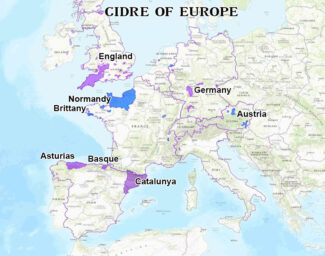
Technically, Brittany ciders are labelled with an Indication Géographique Protégée (IGP), a European label certifying that the drink is made from apples grown in the region, while ciders produced in French Cornouaille – an historical region on the west coast of Brittany – are protected by the Appellation d’Origine protégée (AOP) label, which vouches for the geographical origins of the product and protects the name across the EU. Cidre de Cornouaille AOP unites around 30 cider producers in Brittany.
Normandy cider is also protected by both the IGP and AOP labels; the IGP label indicates bottles with Cidre de Normandie or Cidre Normand. The AOP was labelled for ciders of the Pays d’Auge, an area that takes in parts of the Calvados and Orne departments.
Cidre “Terroir” Or Sense Of Place
When fifteenth century Cistercian monks in Burgundy first began to document the difference in wine quality from various vineyards, they believed that it was a sign from above; that terroir expressed the variegated contours of God’s creation. Although in the modern era, the science of fermentation and a winemaker’s skill in applying and refined production methods have supplanted a monastic explanation for the differences in wine, the quest for a ‘sense of place’ remains alive and well.
In cider production—especially when compared to wine—terroir has traditionally had a less firm hold on the thought processes. For most of the world, cider is a year-long industrial manufacturing process, while in France, especially in controlled appellations, cider is typically made seasonally, following the apple harvest. But like wine from grapes, cider can be redolent not only of the fruit used, but of the locality where it’s grown; the soil, the aspect, the geography and the climate of the orchards. In addition, the age of the orchard is appearing in more and more tech sheet.
All of which is precisely what winemakers call terroir.
The Styles Of French Cidre
The dream-state of most French cidre is to be rich, lush, amber and full of bittersweet apple character; most are low in acidity but well-balanced between the full-bodied fruitiness and tannin. They range from dry to sweet. ‘Fermier’ is farmhouse cidre made where the apples are grown (similar to ‘mis en bouteille au château’ in Bordeaux) and ‘bouché’ refers to the cork stopper, often caged when the cidre is effervescent.
Cidre can be made still or sparkling, desert-style or fortified, or even co-fermented with hops or other fruit juices. So far, the cidres that have impressed us the most have been made from pure, farm-pressed apple juice and electrified with a natural mousse created inside the bottle.
It’s a delightful journey of discovery to the style that best suits your palate, but to take the challenge most authentically, cidre should be sipped from wine glass. Traditionally, country folk could not afford glass, so they used terracotta. The favored receptacles looked like small bowls known as ‘bolées.’
Like wine, many cidres benefit from age. You’ll find that young cidre tends to show strong aromas of fruit ranging from citrus fruit, linden and anise flowers; when fermented in a barrel, notes of caramel, honey and fresh butter appear. In matured ciders have aromatic notes principal among them being vegetal, woody or spicy.
Pairing Cider With Holiday Meals
Cider that’s ‘hard’ contains alcohol, although generally much less than wine, making it (perhaps) a wiser choice through a holiday season that often involves driving from one celebration to another. In Normandy, for example, sweet ciders have a minimum of 3% abv, while drier styles must reach 5% or 5.5% for Cidre Bouché.
With a choice of dry or sweet styles, food pairing is rife with opportunity. There was a time, of course, when the ciders available to Americans tended to be fizzy, fun and largely uninteresting, but with the arrival of complex and sophisticated ciders from France and Spain, they have an obvious place with a large and multi-coursed meal. Perhaps surprisingly, cider may be a better main-course accompaniment since richer wines can steamroll turkey.
While every holiday table is different, a few pointers and tips that should help:
Since the French have long treated fermented apple juice with the near-reverence of wine, passing laws that restrict apple varieties (winnowing 750 varieties grown to about fifty) and delineate appellations, as an opening salvo, a high-end cider makes a quaffable alternative to Champagne.
Cider fermented on wine yeast results in a somewhat vinous cider, with flourishes of acidity and rusticity, a fine alternative to a bright white like Sauvignon Blanc.
Most high-end ciders gravitate toward dryness, but a touch of sweetness can buoy a cider’s complexity, especially tannic and ‘sauvage’ characteristics that might feel unbalanced on their own. These are enjoyable as a swap for an off-dry white like a Riesling.
Cider aged in oak barrels rounds out the edges of tart cider with notes of vanilla, making it hold up against heavier courses much as a barrel-aged white wine might.
Sweet with sweet is a rule of thumb, but the beverage should never overpower the food. For dessert courses (especially pie) a fruity cider works best.
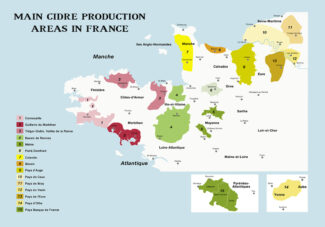
Normandy
Normandy, which most of us associate with the D-Day invasion of 1944, gets a failing grade in being French: They tend to love Americans. They also love apples, and harvest nearly half a million a year, many (but not all) destined to be transformed into Norman Cidre. Throughout the regions of Calvados, Eure, Manche, Orne and Seine-Maritime, cidre is king, although the menu also includes world-class apple juice, pectin jelly and phenomenal apple-based pastries. In the 9th century, Charlemagne ordered more apple trees to be planted in the region, which is too far north and too sunshine-challenged for world-class grape cultivation. In fact, the Normandy AOP contains a single vineyard: Les Arpents du Soleil.
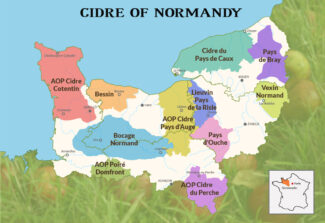
The Norman apple harvest begins in mid-September, when ripe fruit begins to fall from trees naturally. More than 200 varieties of apples are legally permitted; the most common is the Frequin Rouge, followed by distinctive Michelin and Muscadet de Dieppe.
Marie-Agnès Hérout
Maison Hérout
The Contenin Peninsula, part of the staging area for Operation Overlord (the codename of the Invasion of Normandy) pokes its nose far into the English Channel, and was chosen as a landing site for this very reason. Maison Hérout, known for producing some of the driest and most complex ciders made anywhere, has seen many such incursions—the Hérout family tree goes back to the Vikings, who settled in this area around the ninth and tenth centuries. In fact, many Cotentin village names in the still flaunt Norse roots, like the beautiful Briquebec and Quettetot.
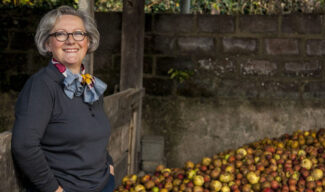
Marie-Agnès Hérout, Maison Hérout
© Hérout Cidres & Calvados
The Hérout estate is located near the town of Auvers, where apples thrive in a lush oceanic climate. The Hérout family began producing cider in the 1940s; today, Marie-Agnès Hérout has taken over the farm and remains true to her heritage by producing some of the finest ciders available from this region. After picking, the apples are grated, macerated, and then pressed with the help of a rack press dating back to 1920, whereupon the juice is left to ferment for four to seven months, often in used Calvados barrels.
Marie-Agnès also continues the family tradition of planting apple trees for future generations and in 2000, began a campaign with the Syndicat de Promotion du Cidre du Cotentin to earn the region’s certification for Appellation d’Origine Contrôlée Cotentin status. In May of 2016, after 16 years of hard work and perseverance, the quest succeeded.
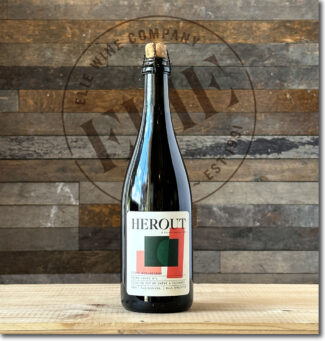 Maison Hérout ‘Micro – Cuvée No 1’, 2019 AOP Cotentin ($23) (Effervescent Brut – Cidre Bio 6.5% abv)
Maison Hérout ‘Micro – Cuvée No 1’, 2019 AOP Cotentin ($23) (Effervescent Brut – Cidre Bio 6.5% abv)
Micro-Cuvée n°1 is an organic cidre distinguished by its orange-yellow color and a fermentation of at least 3 months in used Calvados barrels, which slightly reinforces the alcohol and tannins. Built around Rouge de Cantepie apples from trees between ten and 65 years old, the cidre is fermented for three to five days.
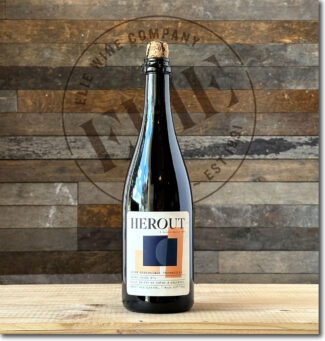 Maison Hérout ‘Micro – Cuvée No 1’, 2020 AOP Cotentin ($23) (Tranquil – Cidre Bio 5.5% abv)
Maison Hérout ‘Micro – Cuvée No 1’, 2020 AOP Cotentin ($23) (Tranquil – Cidre Bio 5.5% abv)
An experimental, still version of the effervescent Brut.
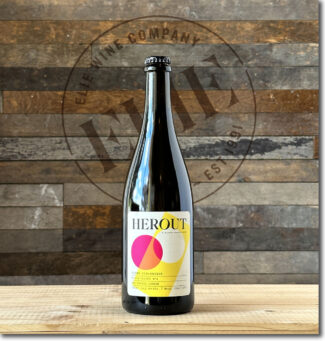 Maison Hérout ‘Micro – Cuvée No 4’, 2020 AOP Cotentin ($23) (Effervescent – Cidre Bio 4% abv)
Maison Hérout ‘Micro – Cuvée No 4’, 2020 AOP Cotentin ($23) (Effervescent – Cidre Bio 4% abv)
A micro-cuvée made of 80% Grasse-Langue, a native Cotentin variety traditionally used for baking. The cuvée is complemented by a blend of bitter and bittersweet varieties to provide structure and balance. The cidre offers aromas of citrus fruits and sour candies behind a balance of bracing acidity.
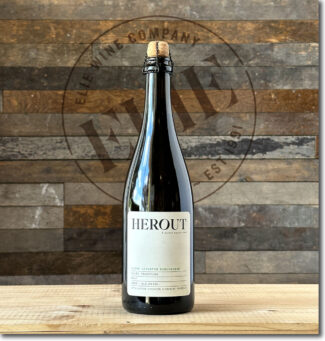 Maison Hérout ‘Cuvée Tradition’, 2020 AOP Cotentin ($18) (Effervescent – Cidre Bio 5% abv)
Maison Hérout ‘Cuvée Tradition’, 2020 AOP Cotentin ($18) (Effervescent – Cidre Bio 5% abv)
Nicely balanced between sweetness and acidity, the cidre offers subtle aromas of butter and dried herbs; acidity is discreet and the palate expresses bitter, integrated tannins.
Cyril Zangs
Jazz-aficionado Cyril Zangs was a book sales rep in Paris before returning to his native Normandy and jumping into the cidre game with both feet. Of the 200 apple varieties approved for cidre making, he uses 69 of them, and in keeping with the natural wine movement, he ferments on native yeasts, unfiltered and without added Sulfur.
After apple quality, Zangs says, it is all about process: “Each of our varieties possesses a particular characteristic (sweet, bittersweet, bitter, slightly acidic or sour) and are harvested from high-stem orchards which range from fifteen to sixty years old. We harvest by hand between early October and mid-December, when apples are the ripest. Our manual selection process ensures that only the best apples are picked—we then separate the apples by variety and store them in our barns to continue ripening for up to six weeks.”
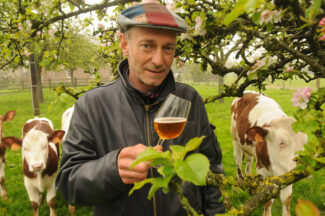
Cyril Zangs
What happens next? In his own words: “Once sorted to obtain the best flavor balance, the apples are grated to create a marc. This is put through to our hydraulic press and the juice is transferred to vats, and racked during the 6 months long fermentation process. It is left undisturbed apart from infrequent racking, or ‘soutirages’. The unfiltered cidre is bottled with no sulfites added and stocked horizontally for two to three months to capture the sparkle. The bottles are then stored on A-racks and regularly turned for three weeks; we then disgorge every bottle by hand, a process that naturally removes the sediment. Each bottle is topped up with the same disgorged cider, with nothing else added.”
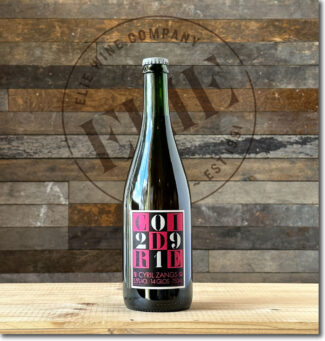 Cyril Zangs ’14 Glos’, 2019 IGP Cidre de Normandie ($27) (Effervescent Brut – Cidre Bio 5.5% abv)
Cyril Zangs ’14 Glos’, 2019 IGP Cidre de Normandie ($27) (Effervescent Brut – Cidre Bio 5.5% abv)
From the tiny commune of Glos in Calvados, Cyril Zangs produces this IGP cidre—IGP, for reference, is an EU quality classification that became valid in 2009; it means Indication Géographique Protégée and supplanted Vin de Pays. ‘14 Glos’ shows a creamy and rich texture, and displays notes of star anise, orange peel and unsurprisingly, bittersweet apple.
Guillaume & Thierry Desfrièches
Cidrerie Léon Desfrièches et Fils
‘Le Père Jules’
“In 1923, my father distilled his first Calvados”, says Léon Desfrièches, current head of the Desfrièches clan, and who has (since 1949) carried on the cidre and distilling traditions put in place by ‘Père Jules.’ In 1976, Léon’s eldest son Thierry joined him, followed by Guillaume, Thierry’s son, in 2002. Jules, Léon, Thierry and Guillaume—four generations of Desfrièches.
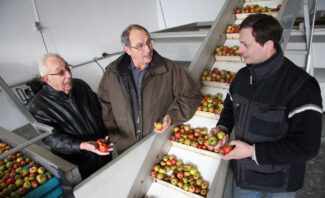
Léon, Thierry & Guillaume Desfrièches, Cidrerie Léon Desfrièches et Fils
Located in the Norman village of Saint Desir, the flagship cidre is made in honor of the late patriarch Jules. Now 85, Léon says: “I would have really liked my father sees what we have accomplished. As for myself, I hope I am like my Calvados: Serene and not afraid of aging with elegance, grace and roundness.”
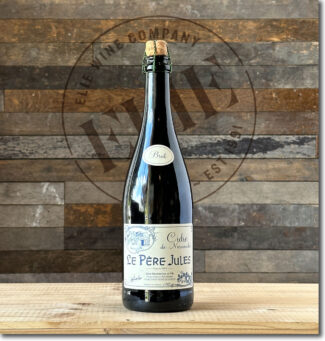 Cidrerie Léon Desfrièches et Fils ‘Le Père Jules’, IGP Cidre de Normandie ($16) (Effervescent Brut – 5% abv)
Cidrerie Léon Desfrièches et Fils ‘Le Père Jules’, IGP Cidre de Normandie ($16) (Effervescent Brut – 5% abv)
Very mature apple notes do homage to the titular Father Jules, showing white flowers and honey. Upfront in the first mouth, it develops an earthy, rich and fruity bouquet with interesting tannins for a long aftertaste.
Brittany
Like Normandy, the apple is emblematic of nearby Brittany; there are over 600 varieties grown (though not all are approved for use) and Breton farm cidre is the ultimate local drink. Orchards abound throughout the region, but sites around Dol-de-Bretagne, the Rennes and Vitré valleys, through the length of the Rance valley and the Vannes region are some of the most heralded. Of somewhat lesser importance to the economy, but still vital to the culture are Pommeau de Bretagne AOO and Eau de Vie de Cidre—a vague Breton answer to Calvados.
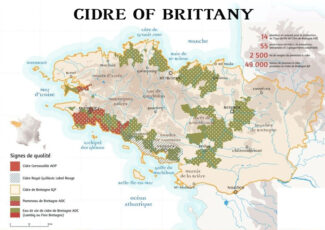
Like wine, Breton cidre celebrates outstanding vintages, and there are a number of officially sanctioned terroirs: Among them, Cidre de Cornouaille was the first product from Brittany to be granted an Appellation d’Origine Protégée. It comes from an area that covers 38 communities around Quimper that meet certain criteria such as hours of sunshine, rainfall or altitude. Cornouaille is a semi-dry cidre made from 100% pure juice and has a golden color, very fine bubbles and a slight hint of bitterness.
Marc Abel & François Desforges
La Cidrerie du Golfe
In 1998, Marc Abel pointed his future away from the cleanliness of a photograph development lab to the dirt of an apple orchard and found a whole new level of pristinity within his soul. After leaving Paris and relocating in Bretagne (for fresh air and an escape from the city rat race) he continued to work as a photographer until 2010, all the while searching for a job that would respond to his inner farmer. In 2011, he happened upon an abandoned cidery four kilometers from his house and took it as a sign.
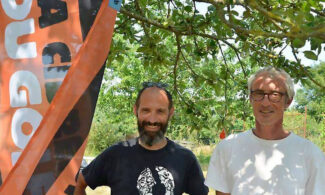
Marc Abel & François Desforges
With the help of his friend François, Marc plunged headfirst into cidre making. An earlier encounter with natural wine convinced his that natural cidre—made without additives—was the route to take. Now, with partner Max, he has created a cidre that embraces natural wine’s philosophy and practices to create a cidre that has gained international notice.
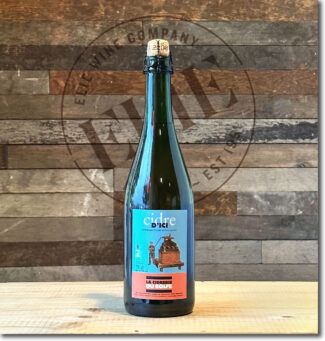 Cidrerie du Golfe ‘Cidre d’Ici’, IGP Cidre de Bretagne ($24) (Effervescent Brut – Cidre Bio 5.5% abv)
Cidrerie du Golfe ‘Cidre d’Ici’, IGP Cidre de Bretagne ($24) (Effervescent Brut – Cidre Bio 5.5% abv)
Twenty different varieties from old ‘found’ orchards combine to create Cidre d’Ici, the flagship cuvée of the cidery. Balanced and fruit-forward with notes ranging from bitter to bittersweet to sweet and sour, the cidre is an ideal accompaniment to sophisticated meals.
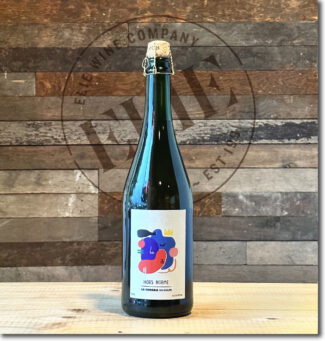 Cidrerie du Golfe ‘Hors-Norme’, 2021 IGP Cidre de Bretagne ($24) (Effervescent Brut – Cidre Bio 5.5% abv)
Cidrerie du Golfe ‘Hors-Norme’, 2021 IGP Cidre de Bretagne ($24) (Effervescent Brut – Cidre Bio 5.5% abv)
Meaning ‘Extraordinary’, Hors-Norme is made with Marie-Ménard, Douce-Coet, Douce-Moen and Judor apples grown in a 23-year-old orchard planted in sandy clay. The cidre is spicy, slightly bitter, and very food friendly.
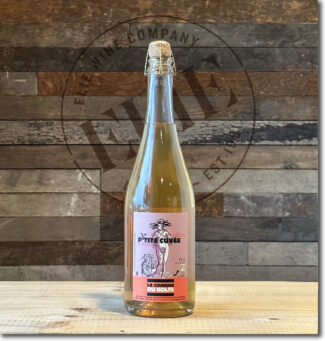 Cidrerie du Golfe ‘P’tite Cuvée’, IGP Cidre de Bretagne ($26) (Effervescent Brut – Cidre Bio 5.5% abv)
Cidrerie du Golfe ‘P’tite Cuvée’, IGP Cidre de Bretagne ($26) (Effervescent Brut – Cidre Bio 5.5% abv)
A monovarietal, meaning that it is made exclusively with one variety of apple; in this case, Guillevic, which is hyperlocal to the region. It results in a crystalline cidre emblematic of the southern Morbihan. It is a ‘cidre de soif’, finely effervescent with delicate acidity and a nice integration of fruit.
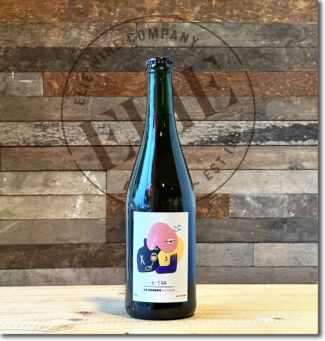 Cidrerie du Golfe ‘X-Tra’, 2021 IGP Cidre de Bretagne ($28) (Effervescent Brut – Cidre Bio 7% abv)
Cidrerie du Golfe ‘X-Tra’, 2021 IGP Cidre de Bretagne ($28) (Effervescent Brut – Cidre Bio 7% abv)
A dozen varieties— Marie-Ménard, Douce-Coet, Douce-Moen, Kermerien, Avrolles, Guillevin, Peau de Chien, Pomme de Moi, Bedan, Petit Jaune, Petit Amer and Judor—make up the cuvée; it is aged two years in tanks and barrels and results in a highly complex, bone-dry cidre with a long, persistent finish.
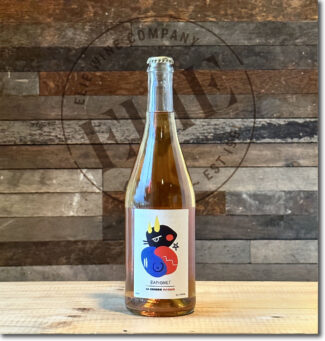 Cidrerie du Golfe ‘Baphomet’, 2021 IGP Cidre de Bretagne ($37) (Effervescent Brut – Cidre Bio 7% abv)
Cidrerie du Golfe ‘Baphomet’, 2021 IGP Cidre de Bretagne ($37) (Effervescent Brut – Cidre Bio 7% abv)
Baphomet is a symbol of balance in various occult and mystical traditions; here, recycled lees (used for making Pommeau) form the core of the fermentation process for the cuvée, resulting in a cider of profound depth and rich aromas with a slight woodiness and an intriguing licorice finish.
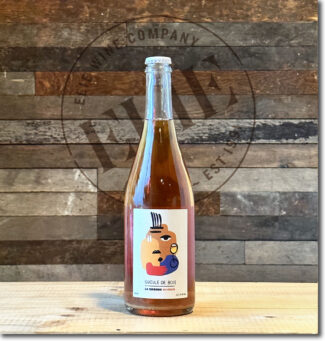 Cidrerie du Golfe ‘Gueule de Bois’, IGP Cidre de Bretagne ($37) (Effervescent Brut – Cidre Bio 7% abv)
Cidrerie du Golfe ‘Gueule de Bois’, IGP Cidre de Bretagne ($37) (Effervescent Brut – Cidre Bio 7% abv)
Translated colloquially to ‘hangover’, Gueule de Bois uses a solera-like method of fermentation, where several generations of apple cider aged between one and nine years create a cider of exceptionally rare complexity.
Hervé Seznec
Cidrerie Manoir du Kinkiz
Hervé Seznec found his calling at an early age and has dedicated himself to produce world-class cidre. At the age of 19 he replanted his 74 acres of family orchards with 25 varieties of cidre-friendly apples. The core of his passion was the creation of natural cidre; as such, he uses no herbicides and allows indigenous plants and grass to grow between the trees.
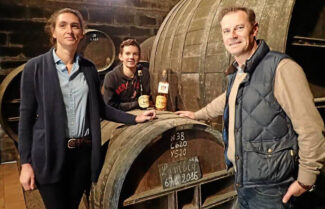
Maugane & Hervé Seznec with their son Louis-Maël, Cidrerie Manoir du Kinkiz
“From the ladybugs that rid our orchards of insects,” he says, “to the almost mystical darkness of the cellars where our AOP Cornouaille cider is aged in huge oak casks, we are making a genuine attempt to return to the hands-on, artisan production methods of our ancestors.”
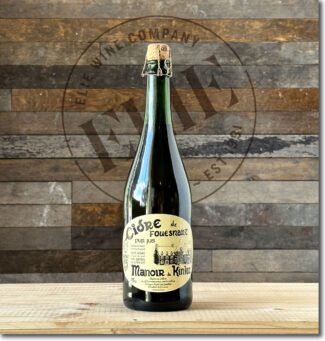 Cidrerie Manoir du Kinkiz ‘Cidre de Fouesnant’ AOP Cornouaille ($15) (Effervescent Brut – 5% abv)
Cidrerie Manoir du Kinkiz ‘Cidre de Fouesnant’ AOP Cornouaille ($15) (Effervescent Brut – 5% abv)
Fouesnant is a commune on the south coast of Brittany renowned for its orchards, regarded as the source of some of the very best Breton cidres. Hervé Seznec maintains, “Our Fouesnant cidre is assembled from old apple varieties, all harvested by hand. The apples are then sorted manually, and pressing is done only when the fruit is at its peak ripeness, from late September to December. The fermentation is slow and ends with a second, 2½ month bottle fermentation, giving the cidre its very fine bubbles. This cidre has a lot of personality and is well-defined by its roundness, persistent flavors of freshly cut apple, complemented by notes of butter and hazelnut.”
François Séhédic
Cidre Séhédic
A recipient of the Prix d’Excellence by the French Ministry of Agriculture for the quality of its product, Séhédic cidres are all certified organic. Located in western Brittany, only the traditional apples of the region are used in production. Although they may sound like a cornucopia of the weird and unpronounceable—Dous Moën, Dous Coët, Marie Menard, Kermerlen, Stang Ru, Trojen Hir and Mad Koz—they all contribute to a complex and age-worthy beverage.
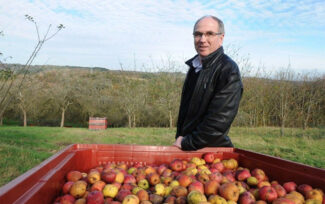
François Séhédic, Cidre Séhédic
Cidre Séhédic has three apple orchards across 45 acres; some of the trees are more than 40 years old. All cidre is made without the addition of sugar, water or SO2. The Séhédic family has been producing cidre since 1950, with the second generation Marie Laure Séhédic and her husband Christian Danielou now running the operation.
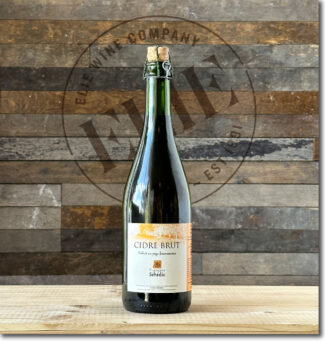 Cidre Séhédic ‘Fouesnant’, IGP Cidre de Bretagne ($15) (Effervescent Brut – Cidre Bio 5.5% abv)
Cidre Séhédic ‘Fouesnant’, IGP Cidre de Bretagne ($15) (Effervescent Brut – Cidre Bio 5.5% abv)
Produced from 30 heirloom varieties: Rich aromas of ginger and cinnamon spiced apple-sauce followed by a finely-textured palate; more savory stewed apple with an appealing acid-driven tartness on the finish, and lasting notes of baking spices and stony minerality.
Cédric Le Bloas
Cidrerie du Léguer
Du Léguer is located six hours directly west of Paris; so far that to go any further west, you’d get your feet wet. In this apple-friendly maritime region, Cédric Le Bloas farms 15 acres, raising artisan varieties like Marie Ménard, Jeanne Renard, Peau de Chien and the sharpest apples, Judor, Locart Vert, Rouget de Dol and Petit Jaune.
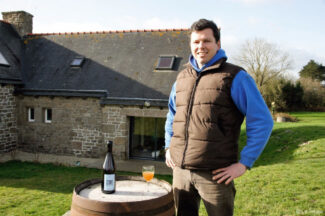
Cédric Le Bloas, Cidrerie du Léguer
© Le Trégor
According to Cédric, “Each cuvée is made according to my taste, however the same process is followed time and again. The trees are hand harvested three times between October and December, before further ripening in crates before pressing up to four weeks later. The cidres go through two ferments: the first lasting five months before bottling, followed by a three month fermentation in bottle. The cidres are bottled with no Sulfur, just pure juice, naturally sparkling and spontaneous, no collage, only racking and filtering when required.”
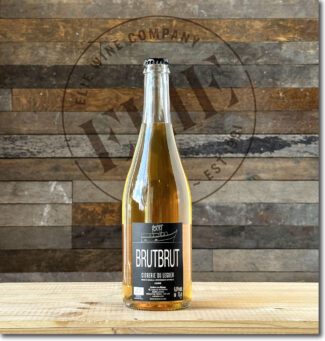 Cidrerie du Léguer ‘BrutBrut’, IGP Cidre de Bretagne ($17) (Effervescent Brut – Cidre Bio 6.8% abv)
Cidrerie du Léguer ‘BrutBrut’, IGP Cidre de Bretagne ($17) (Effervescent Brut – Cidre Bio 6.8% abv)
Sourced from two different orchards, the cidre is made with an apple blend that is 5% bitter, 50% bitter-sweet, 25% sweet, 20% sharp. As with all of Cédric’s cidres, it is made from apples that have fallen and were allowed to further ripen in wooden crates. Cédric uses the old-school process of “keeving” to clean the musts (thus they are not filtered) and all fermentations are natural. The cidre is woody and vinous, showing aromas of dry apples, mild barnyard notes and earth along with a touch of vanilla.
Catalunya
Hard Cider With A Catalan Attitude
‘Sidra’ gets less press than Sherry or Cava, but fermented cider has been a staple throughout Northern Spain—which sees far more rainfall than the vine-loving south—since the first century. Although 80% of Spanish ciders are made in Asturias in the northwest, sidra from Catalunya (like everything Catalan) has its own special personality.
Sidra Catalana is made primarily in the provinces of Girona and Lleida, and unlike some Spanish ciders, tends to have slightly sparkling profile. The town of Olot in the Garrotxa region is known for its cider production and its annual Festa de la Poma.
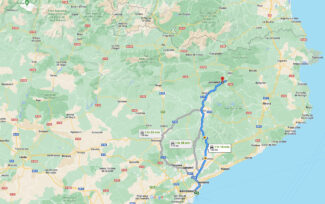
Marc Fuyà
Serps Sidra
Joanetes in La Vall d’en Bas is a four-acre orchard now under the care of Marc Fuyà and provides the source material for Serps—a treasure trove of Catalan sidras as unique and idiosyncratic as Marc himself.
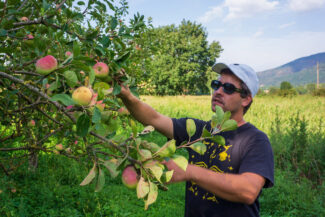
Marc Fuyà, Serps Sidra
After stints cooking in London and Barcelona and playing music throughout the continent, Marc succumbed to the gravitational pull of Girona, where the biodiversity of its environs convinced him that ‘Serps’ would be his retirement plan, a cidery dedicated to rescuing local apples on the verge of extinction. He also draws fruit from several orchards around Girona and the Pyrenees, including some located in a national park and sourced in collaboration with a conservation project.
Noting that many wild varieties of apple only produce in alternate years, Marc jokes, “Apples are much more clever than humans. If you work a lot one year, the next year you go on holidays.”
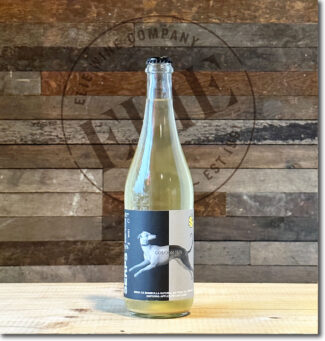 Serps Sidra ‘Gos Com Fux’, 2021 Catalunya (Spain) ($26) (Effervescent Brut – Natural 6.5% abv)
Serps Sidra ‘Gos Com Fux’, 2021 Catalunya (Spain) ($26) (Effervescent Brut – Natural 6.5% abv)
Made with Clon Pink x Gala, Reineta Gris, Golden Russeting, Pink Lady, Judor, Granny Smith apples sourced from coastal orchards in Empordà, the sidra undergoes a 12-hour maceration before pressing. Varieties are co-fermented and undergo a second fermentation after being bottled by hand without fining or filtration.
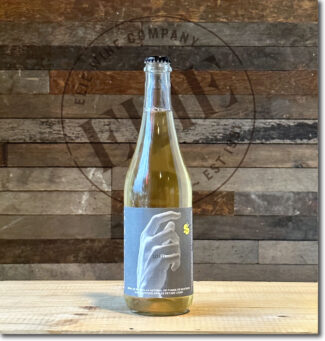 Serps Sidra ‘Lord’, 2021 Catalunya (Spain) ($29) (Effervescent Brut – Natural 7.2% abv)
Serps Sidra ‘Lord’, 2021 Catalunya (Spain) ($29) (Effervescent Brut – Natural 7.2% abv)
A blend of Story Inored, Mandy, Crimson Crisp, Opal, Fengapi, Golden and Manzana Silvestre apples co-fermented on native yeast after a short maceration and press. It is bottled before first fermentation finishes to capture the bubbles in the bottle; no filtration or Sulfur is used.
- - -
Posted on 2023.11.10 in Cidre, Cider, France
Featured Wines
- Notebook: A’Boudt Town
- Saturday Sips Wines
- Saturday Sips Review Club
- The Champagne Society
- Wine-Aid Packages
Wine Regions
Grape Varieties
Albarino, Albarín Blanco, Albarín Tinto, Albillo, Aleatico, Aligote, Arbanne, Aubun, Barbarossa, barbera, Biancu Gentile, bourboulenc, Cabernet Franc, Caino, Caladoc, Calvi, Carcajolu-Neru, Carignan, Chablis, Chardonnay, Chasselas, Cinsault, Clairette, Corvina, Counoise, Dolcetto, Erbamat, Ferrol, Frappato, Friulano, Fromenteau, Gamay, Garnacha, Garnacha Tintorera, Gewurztraminer, Graciano, Grenache, Grenache Blanc, Groppello, Juan Garcia, Lambrusco, Loureira, Macabeo, Macabou, Malbec, Malvasia, Malvasia Nera, Marcelan, Marsanne, Marselan, Marzemino, Mondeuse, Montanaccia, Montònega, Morescola, Morescono, Moscatell, Muscat, Natural, Niellucciu, Parellada, Patrimonio, Pedro Ximénez, Petit Meslier, Petit Verdot, Pineau d'Aunis, Pinot Blanc, Pinot Gris, Pinot Meunier, Pinot Noir, Pouilly Fuisse, Pouilly Loche, Poulsard, Prieto Picudo, Riesling, Rondinella, Rose, Rousanne, Roussanne, Sagrantino, Sauvignon Blanc, Savignin, Sciacarellu, Semillon, Souson, Sparkling, Sumoll, Sylvaner, Syrah, Tannat, Tempranillo, Trebbiano, Trebbiano Valtenesi, Treixadura, Trousseau, Ugni Blanc, vaccarèse, Verdicchio, Vermentino, Xarel-loWines & Events by Date
- July 2024
- June 2024
- May 2024
- April 2024
- March 2024
- February 2024
- January 2024
- December 2023
- November 2023
- October 2023
- September 2023
- August 2023
- July 2023
- June 2023
- May 2023
- April 2023
- March 2023
- February 2023
- January 2023
- December 2022
- November 2022
- October 2022
- September 2022
- August 2022
- July 2022
- June 2022
- May 2022
- April 2022
- March 2022
- February 2022
- January 2022
- December 2021
- November 2021
- October 2021
- September 2021
- August 2021
- July 2021
- June 2021
- May 2021
- April 2021
- March 2021
- February 2021
- January 2021
- December 2020
- November 2020
- October 2020
- September 2020
- August 2020
- July 2020
- June 2020
- May 2020
- April 2020
- March 2020
- February 2020
- January 2020
- December 2019
- November 2019
- October 2019
- September 2019
- August 2019
- July 2019
- June 2019
- May 2019
- April 2019
- March 2019
- February 2019
- January 2019
- December 2018
- November 2018
- October 2018
- September 2018
- August 2018
- July 2018
- June 2018
- May 2018
- April 2018
- March 2018
- February 2018
- January 2018
- December 2017
- November 2017
- October 2017
- September 2017
- August 2017
- July 2017
- June 2017
- May 2017
- April 2017
- March 2017
- February 2017
- January 2017
- December 2016
- November 2016
- October 2016
- September 2016
- August 2016
- July 2016
- June 2016
- May 2016
- April 2016
- March 2016
- February 2016
- January 2016
- December 2015
- November 2015
- October 2015
- September 2015
- August 2015
- July 2015
- June 2015
- May 2015
- April 2015
- March 2015
- February 2015
- January 2015
- December 2014
- November 2014
- October 2014
- September 2014
- August 2014
- July 2014
- June 2014
- April 2014
- March 2014
- February 2014
- January 2014
- December 2013
- November 2013
- October 2013
- September 2013
- August 2013
- July 2013
- June 2013
- May 2013
- April 2013
- March 2013
- February 2013
- January 2013
- December 2012
- November 2012
- October 2012
Search



